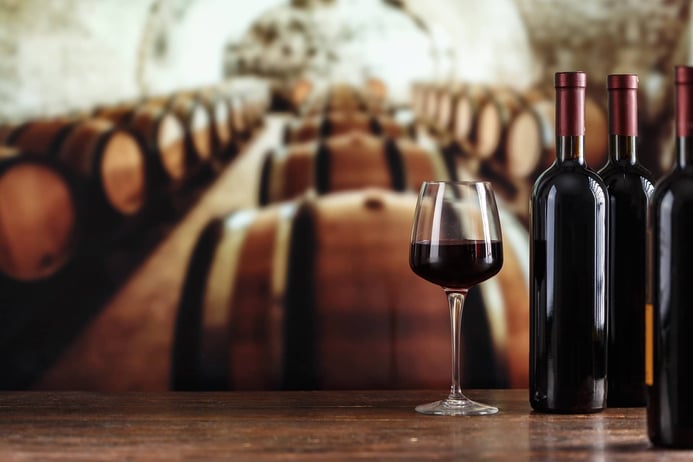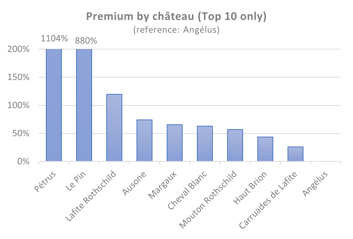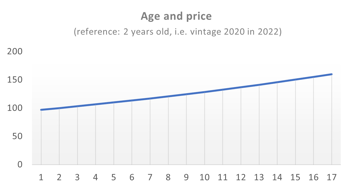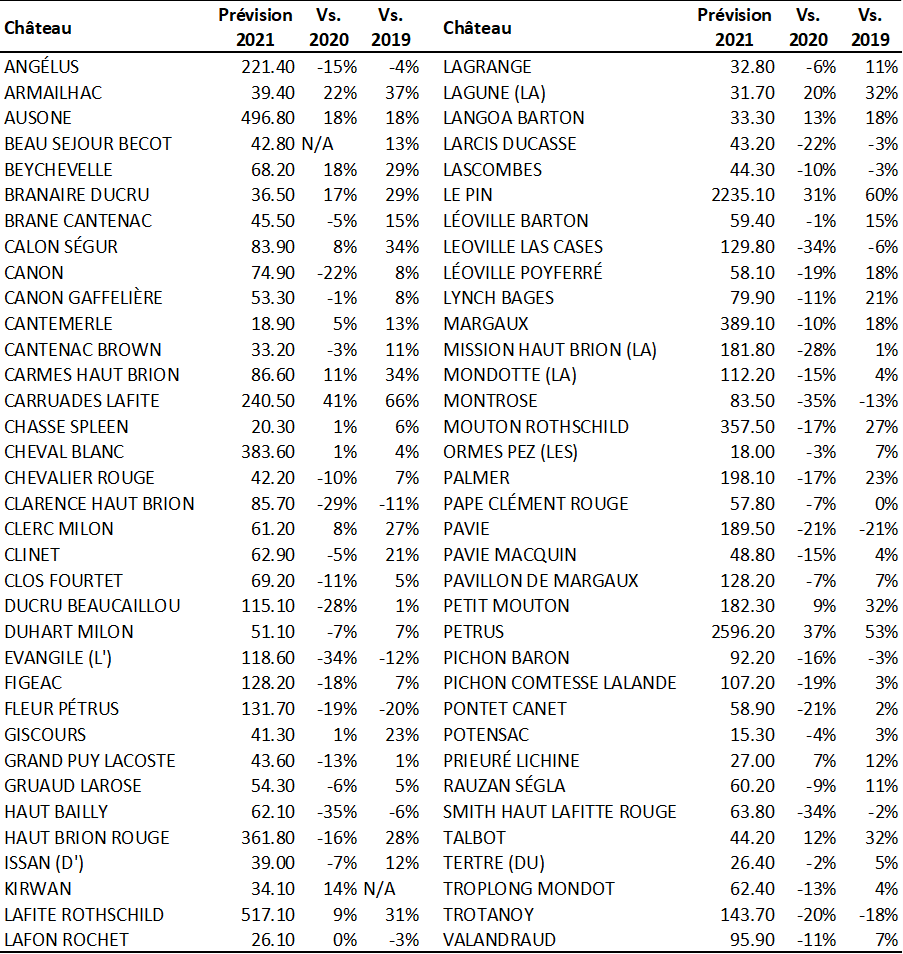The vintage of 2021 Bordeaux wines is a particular one. Contrary to the great years of 2018, 2019 and 2020 which are already considered as forming a historical trilogy (vinous.com, 2022), the year 2021 has suffered the torments of complicated weather. Thankfully, the overall quality, while heterogeneous, seems to be quite satisfactory and even very good for some châteaux. But as for the quantity, it is decidedly low. The context of how to market the 2021 vintage is also particular. Covid has caused the price of fine wines to soar for the past two years, and the sanitary restrictions have now given way to geopolitical uncertainty and inflation hitherto unseen for several decades.
Getting the 2021 vintage right
In the universe of traditional financial assets (stocks and bonds), it is usual to distinguish between primary and secondary markets. The first refers to the moment when an issuer (company or government) sells its securities to investors. The secondary market refers to the market on which investors exchange securities. For the issuer, the question is always to determine the right price at which to sell its securities on the primary market. A price that is too high complicates the sale and, above all, risks damaging the issuer’s reputation. Too low a price means that the issuer is giving up (transferring) value to investors to its detriment. So how to avoid making a mistake? The secondary market provides a wealth of information: where one can see what prices similar securities are trading at. The secondary market thus plays the role of a benchmark and allows to estimate the appropriate release price.
Wine has rather similar characteristics in terms of market organization. The en primeur campaign corresponds to the primary market. In parallel, there is a secondary market centered on the so-called Négociants who are at the heart of the “Place de Bordeaux”. In recent years, this ecosystem has been completed by the emergence of a genuine market platform set up by the London-based company, Liv-ex. The latter uses the transactions recorded on its website to construct price indices. This is proving to be very useful for monitoring market trends in general. Négociants maintain large inventories of many wines whose value fluctuates with demand. They therefore offer a wealth of information about the prices of individual wines.
The role of primary and secondary markets
In a recent paper, Masset & Weisskopf (2022) proposed to exploit the links between secondary and primary markets to infer the prices at which Bordeaux primeurs (aka futures) should be released. Their argument was that the dynamics of primeur prices should remain, at least in the long term, consistent with those of the reference Liv-ex 100 index. Their approach was therefore based on a model of the price variations of the various châteaux from one vintage to the next. This approach has the advantage of requiring only a limited number of variables, including a single benchmark index to capture the dynamics of the secondary market. However, this parsimony also represents a major limitation. Clearly, the use of data at the individual wine level would allow to model prices in a more accurate and reactive framework.
For the present study, it was possible to access data from the Bordeaux trade (négociants). This opens the door to a direct modeling of the prices of the various vintages (and not only of their variations from one vintage to another). This approach is at least complementary to that of Masset & Weisskopf (2022) and probably more refined at the level of individual châteaux.
Bordeaux en primeur prices
The approach is based on two steps. First, secondary market prices are modeled via a regression. The last 16 vintages (2005 to 2020) of a sample of 70 Bordeaux châteaux are taken into account. The model includes variables related to each château’s price level, wine age, vintage quality and scores from The Wine Advocate. Results are reported in Exhibit 1.
The model indicates that the price of a wine on the secondary market depends first of all on the château. The hierarchy is without any surprise: Pétrus, Le Pin and the first classified growths are the most expensive, followed by the super seconds, as well as notably the Carruades de Lafite. Age also plays a role, with each year of ageing resulting in an increase in value of just over 3%. This means that a wine sold en primeur this year must sell for at least 3% less than a wine of similar quality from the previous vintage.
The quality of the vintage (measured by aggregating the evaluations of four international sources/experts) has a considerable impact on demand and therefore on the overall price level of each vintage. Individual scores help refine the price analysis. Note that the relationship between score and price is not linear: extremely well rated wines see their prices increase more than proportionally. Finally, it should be noted that the modeling is extremely accurate since it captures 98% of the price variation of the wines included in the analysis.
In a second step, we can estimate the release prices of the wines of the 2021 vintage. To this aim, one only has to take into account the results of the previous model and combine them with the overall quality level of the 2021 vintage and the individual scores just published by The Wine Advocate. Most experts agree that 2021 is close in quality to the 2012, 2014 and 2017 vintages. We can therefore use this benchmark as a point of comparison to establish an estimate of the overall quality level of the 2021 vintage.
The ex-négoce price forecasts by château, as well as the comparison with the two previous vintages, can be found in Table 1. Overall, considering the vintage as in line with 2014 (the best of the three benchmarks), the model points to a price correction of 7% (median) relative to last year. If we assume that the 2012 vintage (the worst of the three benchmarks) represents a better point of comparison, then we need to subtract about 4% from the estimated prices, which leads to a decrease of 11% as compared to vintage 2020.
This moderate price decline, between 7% and 11% depending on the vintage quality benchmark considered, hides however more nuanced situations depending on the châteaux. Those who enjoy strong demand and who have been reasonable when releasing their 2020 cuvées could afford price increases. On the other hand, some châteaux should revise their prices downwards, sometimes by more than 20%, in order to realign themselves with the model’s forecasts.
Exhibit 1 : Price determinant on the secondary market

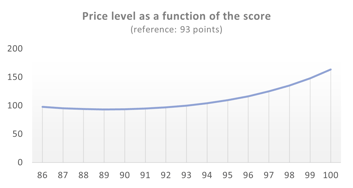
Table 1: Price forecasts of Bordeaux 2021 en primeur wines
Favoring a cautious approach
Our study shows that 2021 Bordeaux prices should be around 7% to 11% lower than the previous vintage to be considered realistic. The few releases so far are broadly consistent with our analysis. However, it should be noted that various elements are difficult to quantify at this stage, notably the impact of the very tense geopolitical situation, inflation and interest rates which are rising sharply. Add to this, financial markets which have become very volatile since the beginning of May 2022 (the data used for the analysis being those of the end of April – just before the beginning of the primeur campaign).
The wine market often takes some time to change direction, especially after a great vintage. It is therefore to be feared that, as was the case for the 1997, 2006, 2011 and 2017 vintages, it will take some time for the market to digest the last great vintages and that prices will only adjust with a certain latency. In fact, over the last three decades, it happened only once that prices retracted promptly after a great vintage: prices of vintages 2001 and 2002 were substantially lower than those of the great 2000 vintage. But this was due to a recession (in 2002 when the 2001 was released) and a war (the invasion of Iraq in 2003).
At this stage, it should be remembered that 2021 is also characterized by a particularly low harvest. This should support prices, at least in the short term. In the longer term, quality will, as always, be the determining factor in the evaluation of these wines. Overall, the above analysis combined with these considerations suggest that a cautious approach should be favored. For châteaux, this means remaining reasonable and opting for release prices that the market can currently bear. For buyers, it means focusing on 2021s sold at attractive prices, i.e. equivalent to, or ideally lower than, those predicted by our model.
